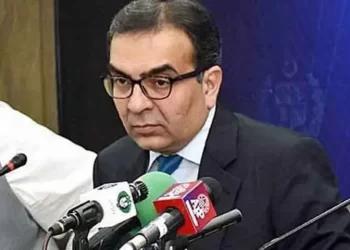KARACHI: The Monetary Policy Committee (MPC) of the State Bank of Pakistan (SBP) on Monday cut the key policy rate by 100 bps to 19.5 percent effective from July 30, 2024 as economic developments are favourable for the inflation outlook.
This is the second and cumulatively 2.5 percent cut in the key policy rate by the committee as in the previous meeting held on June 10, 2024, the rate was reduced by 150 bps to 20.5 percent from the all-time high level of 22 percent.
Addressing a press conference after the committee meeting on Monday at SBP head office, Governor SBP Jameel Ahmed said that inflation has significantly declined from 38 percent (May 20243) to 12.6 percent in June 2024, which was slightly better than anticipated. Average inflation is expected to remain in the range of 11.5-13.5 percent in FY25, down significantly from 23.4 percent in FY24. Therefore, the committee has decided to further cut the policy rate by 100 bps, he added.
He informed that the Committee also assessed that the inflationary impact of the FY25 budgetary measures was broadly in line with earlier expectations. In addition, the external account has continued to improve, as reflected by the build-up in SBP’s FX reserves despite substantial repayments of debt and other obligations.
“Considering these developments along with a significantly positive real interest rate the Committee viewed that there was a room to further reduce the policy rate in a calibrated manner to support economic activity, while keeping inflationary pressures in check,” Governor said.
He said that on balance, after considering current trends and accounting for the sufficiently tight monetary policy stance and ongoing fiscal consolidation average inflation is expected to remain in the range of 11.5-13.5 percent in FY25, down significantly from 23.4 percent in FY24.
He informed that real GDP growth is projected in the range of 2.5 to 3.5 percent in FY25 as compared to 2.4 percent recorded last year due to strong performance of the agriculture sector and recovery in activities of the industry and services supported by relatively lower interest rates and higher budgeted development spending.
After recording surpluses for three consecutive months, the current account posted a deficit in May and June due to higher dividend and profit payments and a seasonal increase in imports, which more than offset a significant increase in exports and workers’ remittances, he mentioned.
Cumulatively, the Governor said that the current account deficit in FY24 narrowed significantly to 0.2 percent of GDP from 1.0 percent in the preceding year. This, along with the revival of financial inflows, helped build the SBP’s FX reserves.
He said that despite some modest increase in imports, the current account deficit is expected to contain and will be in the range of 0-1.0 percent of GDP in FY25 supported by continued robust growth in workers’ remittances, along with an increase in exports.
The committee also noted that since the last MPC meeting, there were a number of developments on the economic front. First, the current account deficit narrowed sharply in FY24 and SBP’s FX reserves improved significantly from $4.4 billion at end-June 2023 to above $9.0 billion.
Second, the country reached a staff level agreement with the IMF for a 37-month EFF program of about $7.0 billion. Third, sentiment surveys conducted in July showed a worsening in inflation expectations and confidence of both consumers and businesses.









